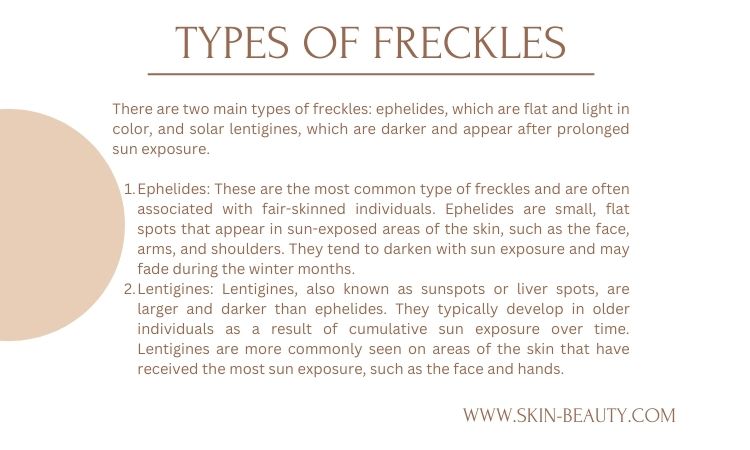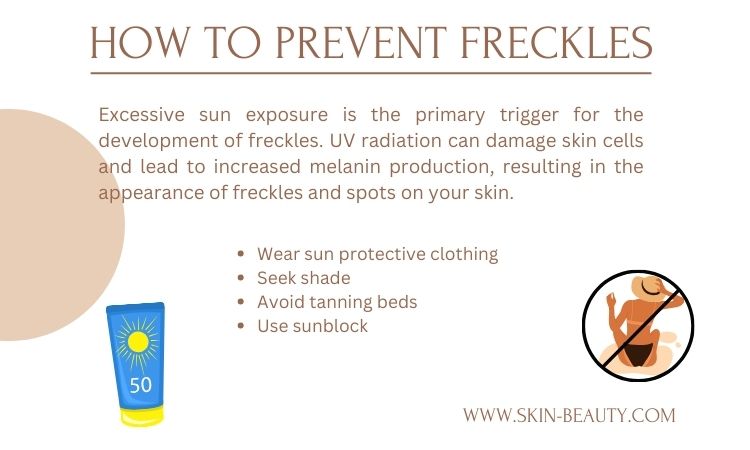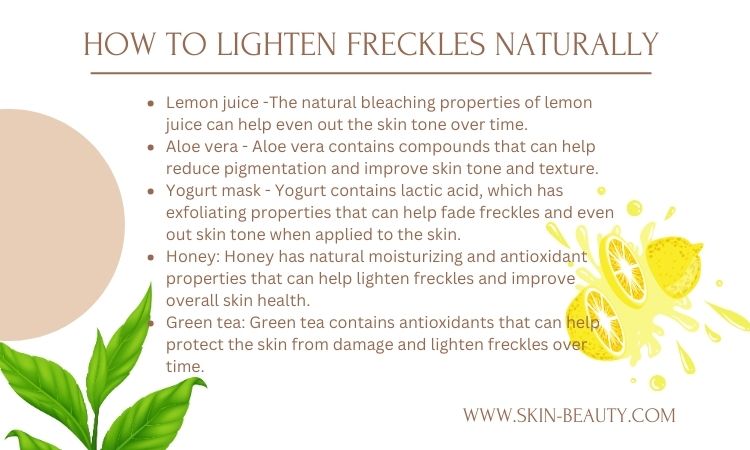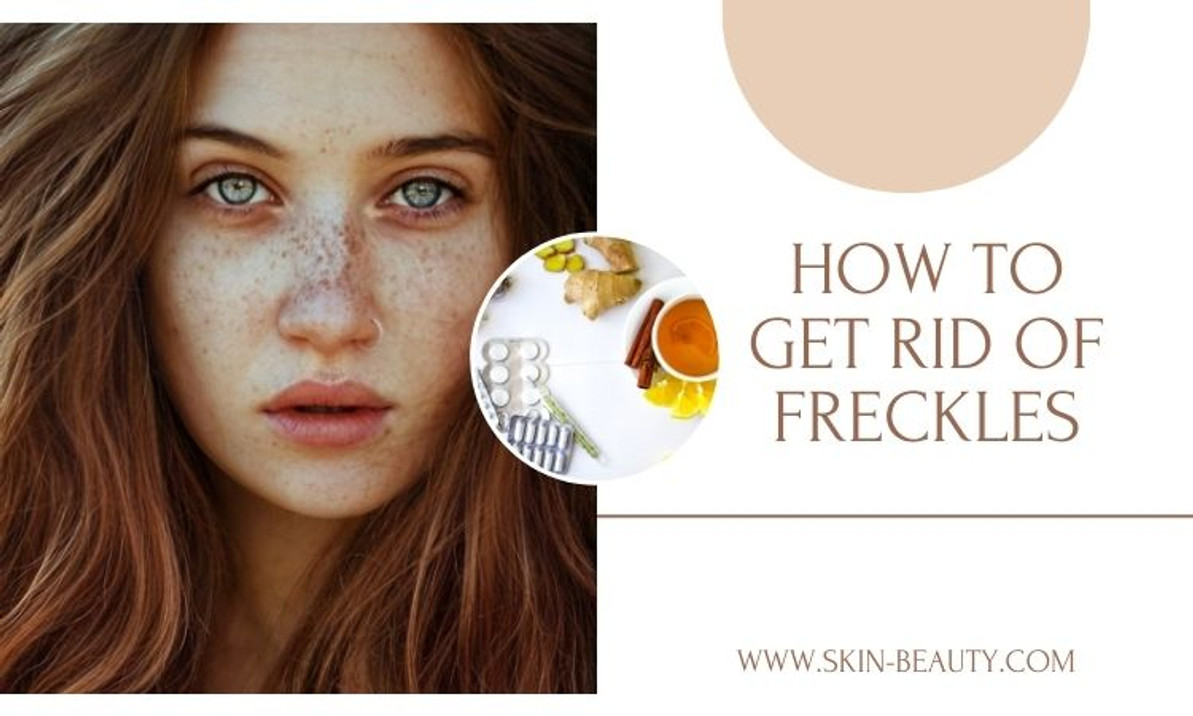How to Get Rid of Freckles and Achieve a Clear, Glowing Complexion
How to Get Rid of Freckles
Freckles are small, flat, brown spots on the skin caused by an accumulation of melanin, the pigment responsible for skin color. They usually occur as a result of sun exposure and are more common in individuals with fair and light skin. While freckles are harmless, many people seek ways to reduce or remove them for cosmetic reasons. Here's everything you need to know about freckles and how to prevent freckles from appearing.
What Are Freckles and How Do They Form?
Freckles are noncancerous, small, pigmented spots on the skin, typically tan or light brown in color, that are often more noticeable on fair-skinned individuals. They result from the uneven distribution of melanin in the skin. When exposed to sunlight, the skin produces more melanin to protect itself, leading to the formation of freckles. While genetics play a role in freckle formation and are born with freckles, sun exposure is the primary trigger.
Causes of Freckles
Freckles are primarily caused by exposure to ultraviolet (UV) radiation from the sun. When the skin is exposed to sunlight, it triggers the production of melanin by melanocytes, which are specialized cells in the skin. Melanin helps to absorb and dissipate the UV radiation, protecting the deeper layers of the skin from damage. In individuals with fair skin, melanocytes may produce more melanin in response to sun exposure, leading to the formation of freckles. Genetics also contribute to the likelihood of developing freckles, as they tend to run in families.

Types of Freckles
There are two main types of freckles: ephelides, which are flat and light in color, and solar lentigines, which are darker and appear after prolonged sun exposure.
- Ephelides: These are the most common type of freckles and are often associated with fair-skinned individuals. Ephelides are small, flat spots that appear in sun-exposed areas of the skin, such as the face, arms, and shoulders. They tend to darken with sun exposure and may fade during the winter months.
- Lentigines: Lentigines, also known as sunspots or liver spots, are larger and darker than ephelides. They typically develop in older individuals as a result of cumulative sun exposure over time. Lentigines are more commonly seen on areas of the skin that have received the most sun exposure, such as the face and hands.
Preventing New Freckles from Forming
Below are some tips to help prevent new freckles from forming.
- Sun protection: Since exposure to sunlight is a primary trigger for freckle formation, protecting your skin from the sun is crucial. Use broad-spectrum sunscreen with a high SPF (Sun Protection Factor) of 30 or higher, and reapply it every two hours or more frequently if swimming or sweating. Wear protective clothing, such as wide-brimmed hats, long-sleeved shirts, and sunglasses, when outdoors.
- Seek shade: Limit your time spent in direct sunlight, especially during peak UV radiation hours, which are typically between 10 a.m. and 4 p.m. Seek shade under trees, umbrellas, or other structures when outdoors.
- Avoid tanning beds: Artificial sources of UV radiation, such as tanning beds, can also contribute to freckle formation and increase your risk of skin cancer. Avoid using tanning beds altogether.
- Use sun-protective skin care: Incorporate skincare products that contain ingredients known to protect the skin from sun damage, such as antioxidants like vitamin C and E, or botanical extracts like green tea. These products can provide additional protection and support the skin's natural defense mechanisms.
- Consider topical treatments: Some topical treatments, such as hydroquinone or retinoids, may help get rid of dark spots and reduce the appearance of existing freckles or inhibit melanin production in the skin. However, it's essential to use these treatments under the guidance of a dermatologist to avoid adverse effects or skin irritation.
- Stay hydrated: Proper hydration supports overall skin health and may help maintain the skin's natural protective barrier. Drink plenty of water throughout the day to keep your skin hydrated and supple.

Popular Methods for Removing Freckles
There are several freckle removal treatments to reduce or eliminate freckles, ranging from topical treatments to medical procedures. Treatments for removing freckles can vary based on your skin type and goals. Here's how to get rid of hyperpigmentation and for lighter and brighter skin.
Laser Treatment for Freckles
Laser treatment for freckles involves targeting the melanin in the skin with intense pulses of light to break it up and reduce the appearance of freckles. It is a popular and effective option to remove your freckles. Laser treatment is often recommended for individuals with stubborn freckles who have not responded to other treatments. It can target specific areas of pigmentation with precision. There are several types of lasers used for treating freckles, including Q-switched lasers, fractional lasers, and intense pulsed light (IPL) devices. Each type of laser works differently, targeting melanin in the skin to break down pigmentation and help get rid of your freckles.
Chemical Peel for Freckle Removal
A chemical peel is a procedure that involves applying a chemical solution to the skin to exfoliate the top layers and reveal smoother, less pigmented skin underneath. It can help improve the appearance of freckles. Both chemical peels and laser freckle removal are effective options for freckle removal. The choice between the two will depend on factors such as skin type, the severity of freckles on the face, and individual preferences. There are different types of chemical peels available, ranging from superficial peels to deeper peels. Superficial peels primarily target the outermost layer of skin (epidermis), while deeper peels penetrate deeper into the skin layers. The type of chemical peel recommended will depend on factors such as the severity of the freckles and your skin's condition.
Using Topical Creams And Retinoid Cream for Treating Freckles
Topical creams containing ingredients such as retinoids or hydroquinone can help lighten freckles on your face over time by reducing melanin production in the skin. Retinoid creams, derived from vitamin A, can help improve skin texture and reduce the appearance of freckles over time. They work by promoting cell turnover and enhancing collagen production.

Natural Methods To Lighten Your Freckles
While methods to remove freckles naturally may not completely eliminate freckles, they can help lighten their appearance over time. Here are some natural methods that may help:
- Lemon juice: The natural bleaching properties of lemon juice can help even out the skin tone over time. Apply freshly squeezed lemon juice to the affected areas using a cotton ball and leave it on for about 10-15 minutes before rinsing it off with lukewarm water. Repeat this process daily for best results, but be cautious as lemon juice can make your skin more sensitive to sunlight.
- Aloe vera: Aloe vera contains compounds that can help reduce pigmentation and improve skin tone and texture. Apply fresh aloe vera gel directly to the freckles and leave it on for 15-20 minutes before rinsing it off with water. Repeat this process twice daily.
- Yogurt mask: Yogurt contains lactic acid, which has exfoliating properties that can help fade freckles and even out skin tone when applied to the skin. Apply plain yogurt to the freckled areas and leave it on for 15-20 minutes before rinsing it off with lukewarm water. Repeat this 2-3 times per week.
- Honey: Honey has natural moisturizing and antioxidant properties that can help lighten freckles and improve overall skin health. Apply raw honey directly to the freckles and leave it on for 10-15 minutes before rinsing it off with warm water. Repeat this process daily.
- Green tea: Green tea contains antioxidants that can help protect the skin from damage and lighten freckles over time. Brew a cup of green tea and allow it to cool. Apply it on the skin with a cotton dipped in the tea. Leave it on for 15-20 minutes before rinsing it off with water. Repeat this process daily.
Understanding the Role of Sun Exposure in Freckle Formation
Excessive sun exposure is the primary trigger for the development of freckles. UV radiation can damage skin cells and lead to increased melanin production, resulting in the appearance of freckles and spots on your skin.
Sun Damage and Freckles
Skin exposed to the sun and its harmful UV rays can not only cause freckles and pigmentation but also increase the risk of skin cancer and premature aging. It is essential to protect your skin from the sun's harmful effects to prevent sun-damaged skin. Not potecting the skin will result in developing more freckles.
Preventing New Freckles Due to Sun Exposure
To prevent new freckles from forming due to sun exposure, always wear sunscreen, seek shade during peak hours, and wear protective clothing such as hats and sunglasses. Taking these precautions can prevent freckles in the future.
Addressing Freckles for Different Skin Types
Treatment of freckles may vary depending on an individual's skin type, tone, and existing skin conditions. Consulting a dermatologist can provide personalized recommendations.
How Skin Tone Affects Freckle Appearance
Individuals with fair and lighter skin are more likely to have freckles due to lower melanin levels, while those with dark skin may have fewer freckles but are still at risk of sun damage and hyperpigmentation.
Dealing with Freckles on Different Skin Conditions
It's essential to consider existing skin conditions when addressing freckles, as some treatments may exacerbate certain skin issues if you have sensitive skin. A customized approach is crucial for the best removal method for optimal results.
Consulting a Dermatologist for Freckle Removal
If you are struggling to manage your freckles or are concerned about changes in your skin, it's advisable to seek professional help from a dermatologist who can assess your skin's specific needs and offer different treatment options to help remove the freckles.
Recent Posts
-
Peptides For Skin: Exploring the Anti-Aging Benefits of Peptides in Skincare
Exploring the Anti-Aging Benefits of Peptides in Skincare In the universe of advanced skincare, th …Apr 25th 2024 -
Discover the Perfect Glasses & Styles to Enhance Your Rectangle Face Shape!
Your face shape plays a significant role in determining the most flattering hairstyles and makeup te …Apr 17th 2024 -
Moroccanoil Treatment for Hair: The Ultimate Guide
Moroccanoil Treatment for Hair: The Ultimate Guide In the world of hair care, few products have ca …Apr 1st 2024




